“I am going to talk about the things I am passionate about, one is having the horse light to the aids, because I think this is nicer for horses in terms of their well-being and their mental state, in the long run…”
Chris Hector interviews Chris Burton, and sits in on his Equitana Masterclass…
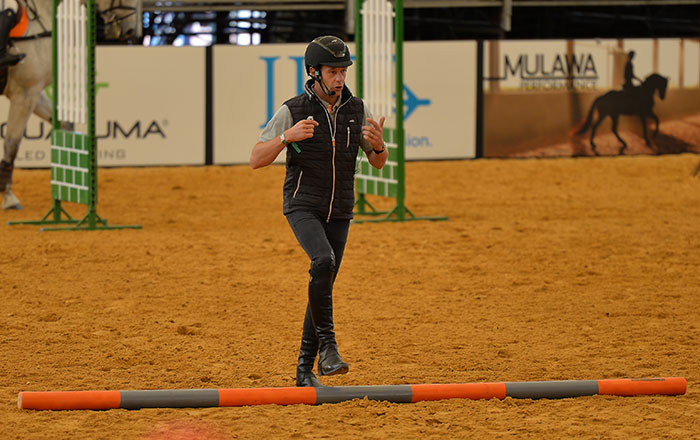
Christopher Burton had three very talented riders for his Masterclass at Equitana, Madeleine O’Callaghan riding Equine Affair Mystique, Erin Callahan and Danson Lincoln, and Sophie Doake with Grandjany.
Why is it that the standard of dressage riding with our young eventers tends to be higher than the standard for the young (and for that matter old) dressage riders?
In an interview before the class, Christopher outlined his plans:
“I always try to think about things that are topical, and try to always make it very interesting, because we’ve all seen Masterclasses that drag on and get a bit boring. I’ve been lucky enough to have done a few of them, and that helps, but I’ll still be nervous about doing a good job. I am going to talk about the things I am passionate about, one is having the horse light to the aids, because I think this is nicer for horses in terms of their well-being and their mental state, in the long run, and I do want to talk about making the time across country. That’s very topical, certainly with me at the moment, and it is something I get asked about a lot.”
Chris is well known for riding within time on the cross-country course.
Madeleine was riding the greenest horse in the class and Christopher pointed to the improvement in just twenty-four hours. “Yesterday when we did trot to halt, the horse threw his head in the air, he was trying to educate Maddy, I’m taking you for a ride not the other way around, and today Maddy is educating her horse and he is responding.”
“I think part of the problem is that a lot of riders don’t understand that the horse is not born knowing that pressure on the mouth means stop, you have to teach them that. They don’t instinctively know that pressure from the leg means go, we have to teach them that.”

“Look at Erin, she is very light with her stop aid, almost forward hands in the halt. When you start with a breaker they say don’t touch my mouth and you have to repeat, repeat, until you can stop on the lightest aid.”
Let’s talk about light and on the aids…
“We’ve all seen light riders that are completely ineffective and this is a waste of time as well. But we do see tough riders that are always riding with strong aids, heavy with the hands and never releasing the pressure, and that’s something I’m very passionate about, something I hate seeing. I think it is something that even the FEI should be cracking down on…”
“To train a horse, all we’ve really got is pressure and release and the truth is, you often need to be stricter or tougher to get the light result in the end, but it is a far nicer result in the long term.”
“Really if you tap someone repetitively on the forehead, it is a form of torture. Better to say once, this is the boundary, don’t step over it, then you can be fair.”
“If the horse doesn’t stop, you have to be strict. I want light, but sometimes you have to be strong to get there.”
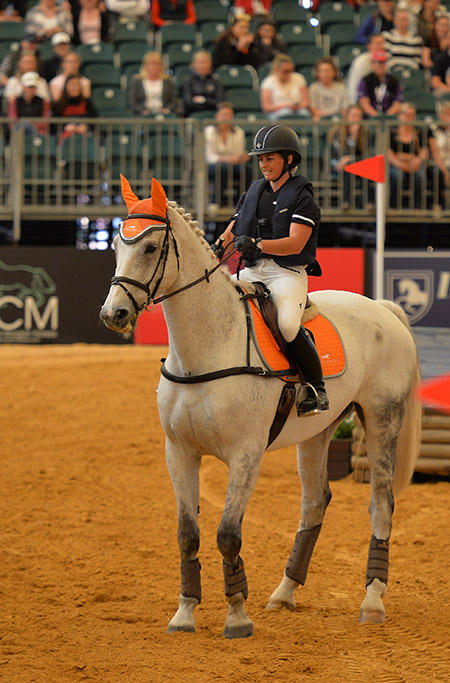
Sophie’s Grandjany was getting a little excited in the atmosphere inside the big arena.
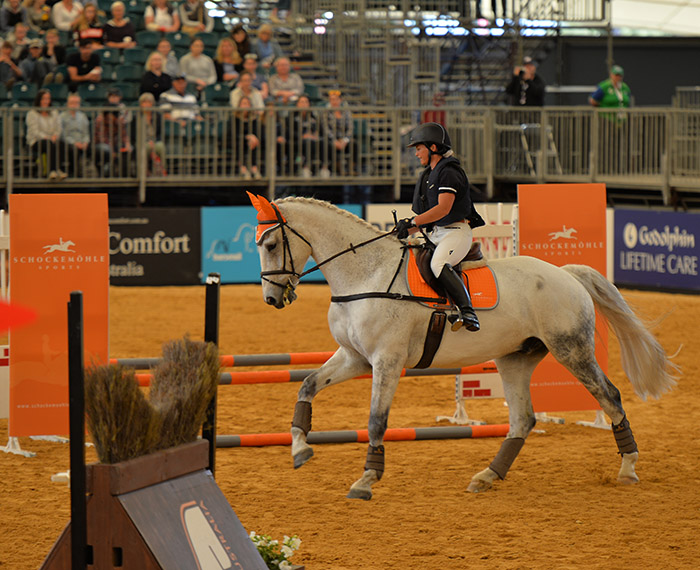
Sophie rides Grandjany on a circle to settle him…
“If you ride a straight line the horse will get stronger, ride a circle, bend him, bend him. If he is not listening to the half halt, what do we do? We make a halt. When I am teaching, I ask riders,what is a half halt? And I get these elaborate explanations involving seat and legs, no – a half halt is half a halt.”
“Some instructors tell you it’s your seat. Okay, gallop round the paddock and stop on your seat! Sure, as you are refining the halt, you use your back first, and eventually they stop on your seat, but the seat is the last thing. If someone tells you to ride first with your seat, get out of the arena and go home.”
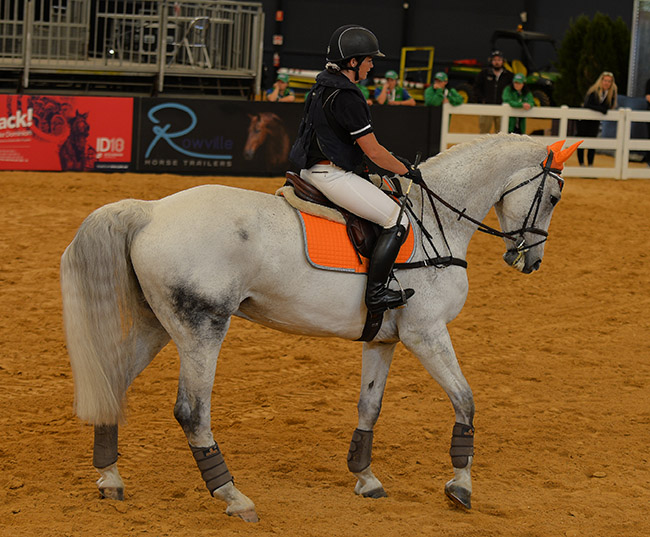
Sophie controlling the adrenalin
“It is important when you are working at home to try and create the sort of adrenalin you are going to have to deal with when you take the horse out. Give him a kick, create adrenalin and learn to control it.”
Have you ever noticed that all the great riders use poles in their training? And, of course, Chris is no exception.
“It’s so easy, go to Bunnings, buy two poles for $9.50 each, and you’ve got all you need to train a top eventer. Seeing a distance to a pole is the same as seeing a distance to a six feet wall or a three-star fence. Work on getting the pole in the middle of the stride.
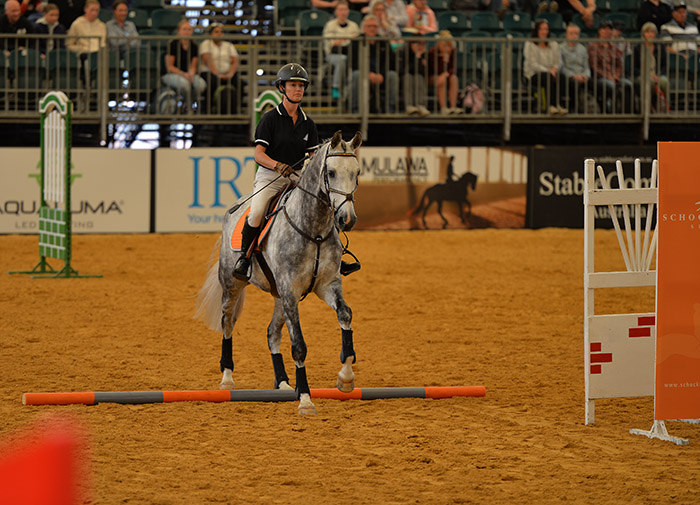
Erin Callahan and Danson Lincoln demonstrate the poles exercise
When I was a kid, I used to practice walking down the street, I’d pick a crack in the pavement, and try to get it in the middle of my stride. Then I was talking with Shane Rose one day, and he did the same on his way to school.”
“On the approach, a good rider will adjust to get to get the pole in the middle of the stride, you need to practice over poles before you go jumping. A good rider can see if he is going to be short or long, and adjust, but you won’t even see him do it.”
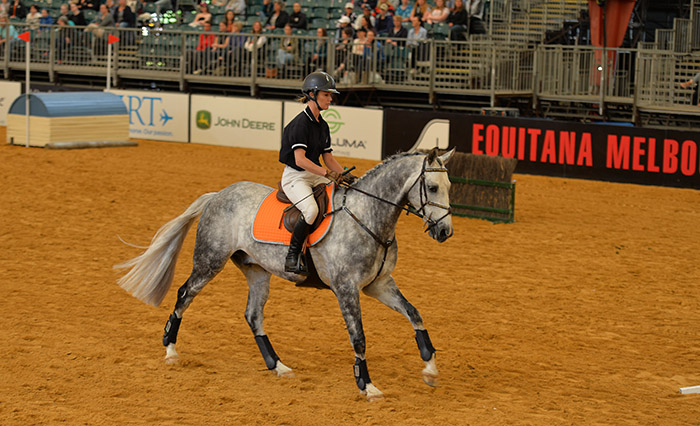
“I want you to canter over these two poles then walk. How many strides?”
“Eight.”
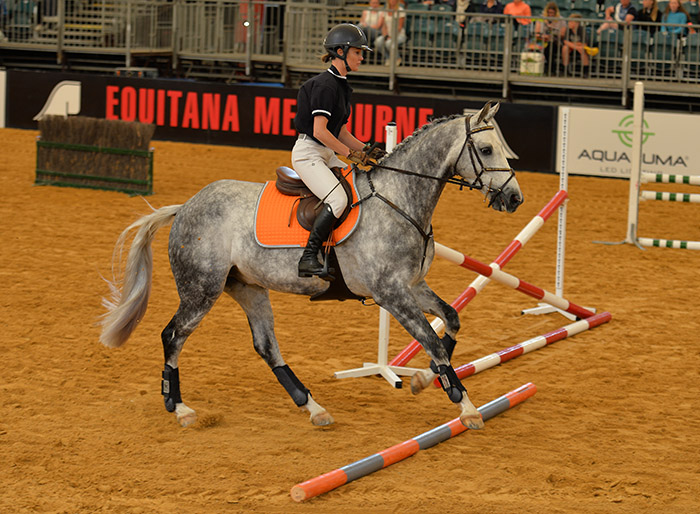
“Good girl, now seven.”
“Now let’s try six. Open up the gallop – we live on an island, there’s nowhere for them to go. And if you don’t get a good distance to the first rail, circle.”
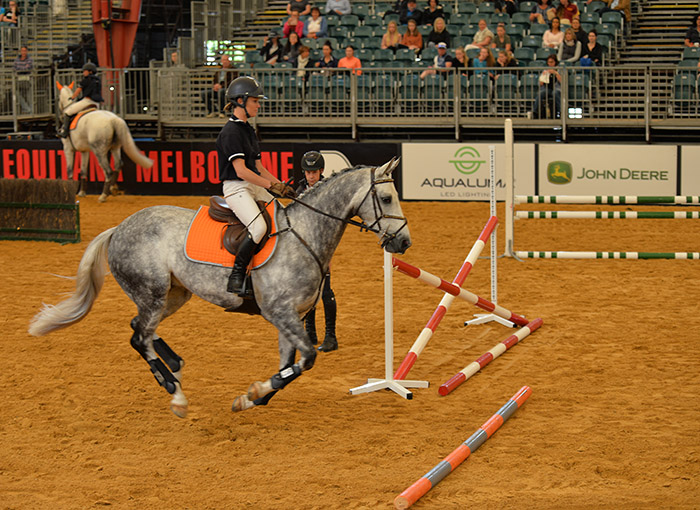
“Now collect, eight strides. There that was the first horse to get the eight and make it look pretty. Now ten, did I hear you say, poor little young horse? No, he has to learn.”
“That was eleven. This is one of the most common things I see, you have to be strict on yourself, we want a specific number, ten not eleven, work on your eye.”
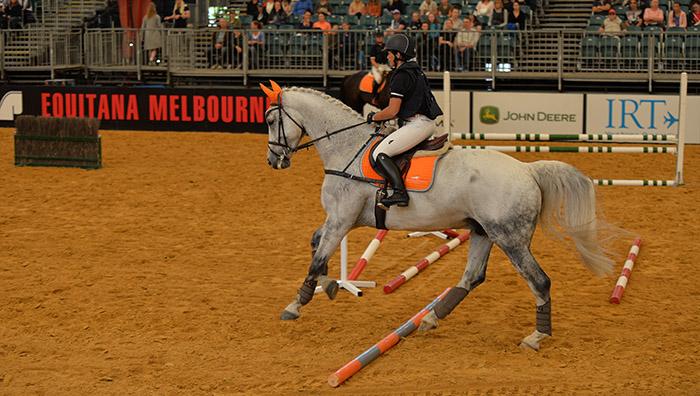
Sophie practises shorten
“This is something you have to practice every day. I still do it now.”
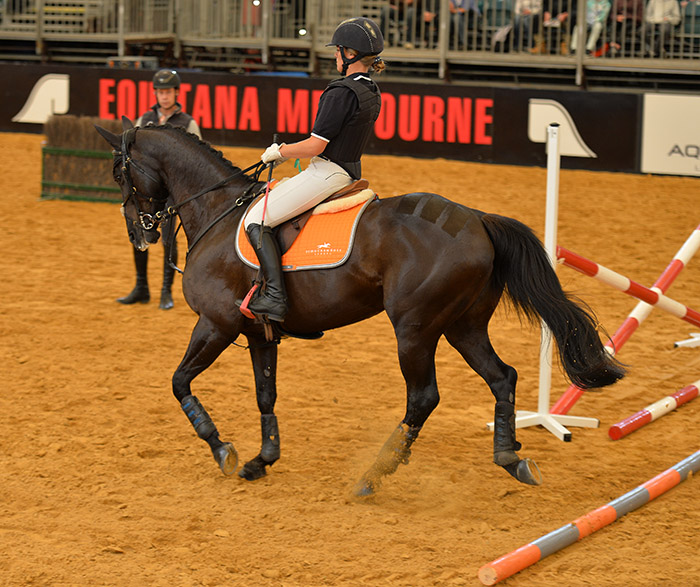
Maddie, stop followed by…
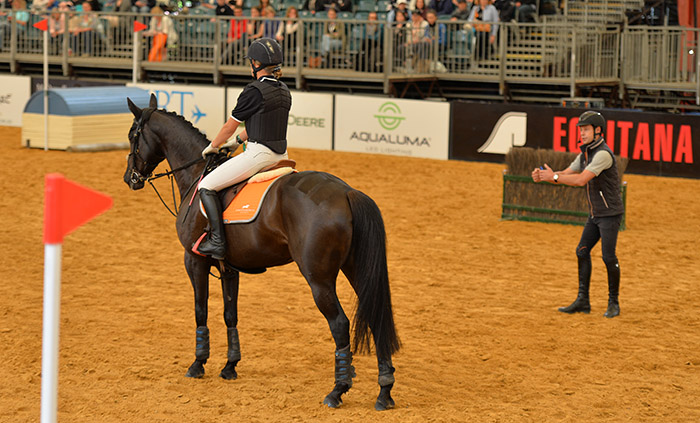
a quick release
Maddy was back working on Mystique’s halt.
“Make him stop, that’s quite a strong aid, if any of you are offended, you can leave, but it is followed by a quick release. Too many riders go straight to the strong aid and don’t train the halt. No, you are aiming at soft first. Use your voice, it’s the softest lovely aid. Use it in your showjumping, don’t tell the judges, but use it in your dressage. I can use it from 20 metres away to get a horse stand still in the wash bay.”
“You want to have your horses in neutral cruise, they keep doing what you’ve asked them to do, by themselves, until you ask them to do something else.
100%, by themselves is the point. You can’t hold a horse, you are sitting on its back, the only way to hold them is to get off and put your feet on the ground. You’ve got to ask the horse, teach the horse, show it what you want it to do.”
“Anyone using their spur every stride, should be yellow carded and kicked out of the sport. Use your whip, get a response, then ask again with your leg, and get a light response.”
You prefer to do this with the lightest possible gear on their heads?
“I’m not big on bits. Another gripe of mine is the people who go into bigger bits when they actually haven’t got true control. I often warn riders when I teach, okay you’ve got a big bit, but there’s still a fundamental problem – when I pull on the reins, the horse doesn’t stop. Then once they learn, and they educate the horse, then they can go back to a snaffle.”
Christopher set up a little line, a cross rail, a little oxer “then halt, and do it on your voice.”
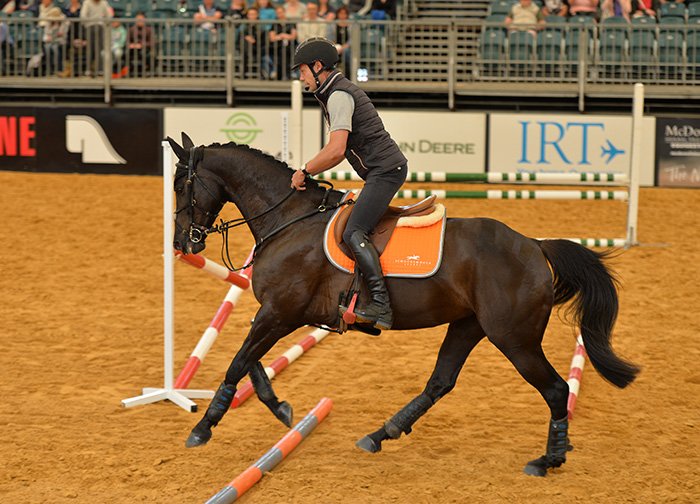
Chris demonstrates on Mystique
“Get the distance right and relax your arm. You can’t help your horse off the ground. Be careful there, your hands came back a little over the fence, stay steady and don’t rotate your hands.”
“There’s a myth about young green horses. Don’t jump them too high, it’s mean to them, they are too inexperienced. Wrong – watch a few three-year-olds going free jumping down a jumping lane.”
“Don’t be frightened to put leg on at the base of the fence, make them confident to leave the ground. Put leg on, get deeper and knock a front rail – that’s good for them.”
Christopher sets up some angled rails, and points out that you can “keep making the angled rails steeper until the line is almost one horse wide. I’m still seeing too much back with the hands at a fence girls – this is not 1980!”
Christopher had rails set up to make riding the corner easier: “Don’t set them up for failure. Never go to a corner without a rail to help when you are training – don’t allow your horse to learn to run out. Your reins are too short – reins won’t help, get your eye and get the distance. Put your bum in the saddle and let go the reins, come round the corner, find your line and don’t touch…”
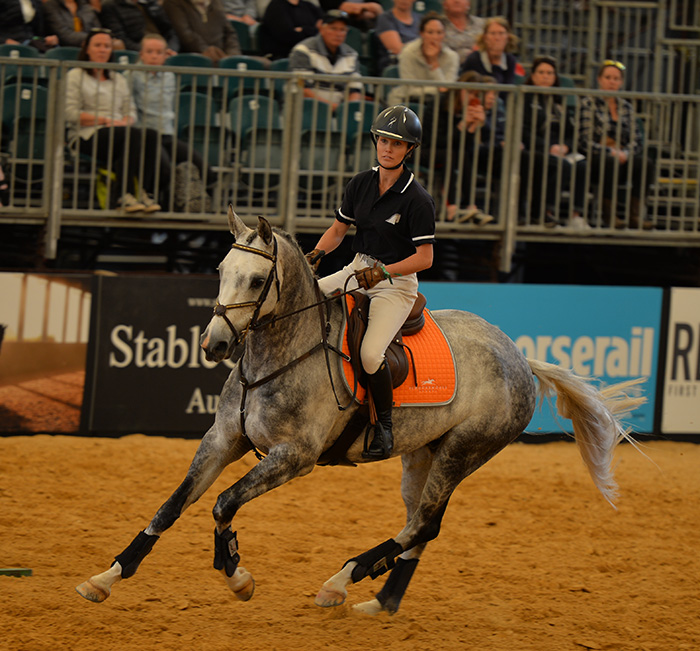
Christopher finished his session with a fun demonstration of how the riders could find smarter lines, ride slower and still go faster, cutting just on ten seconds off the time for all three.
Christopher Burton is a great rider, but he is also an exceptional teacher, and he thinks deeply about his sport.
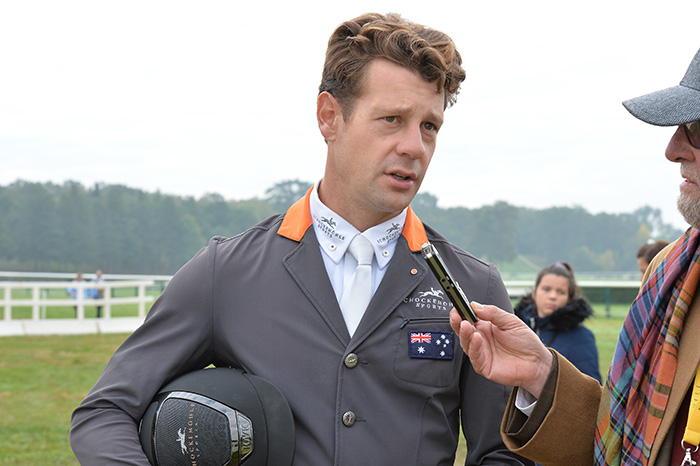
Do you think the eventing world is moving more in the direction of lighter, more sympathetic riding? Michi Jung has shown how effective this style is, you have been incredibly successful with your light style – is the old crash and burn on the way out?
“I would hope so. In all the equestrian disciplines, I think that is on its way out. Right now we are seeing some really top riding in the sport of eventing, and what is good is that we are seeing really excellent eventing dressage riding, excellent eventing showjumping riding, the sport is definitely going in that direction and it must continue to go in that direction. We need tougher dressage, we need higher showjumping and my little thing, as I think you probably know, is that we should have short format, but that’s a separate issue…”
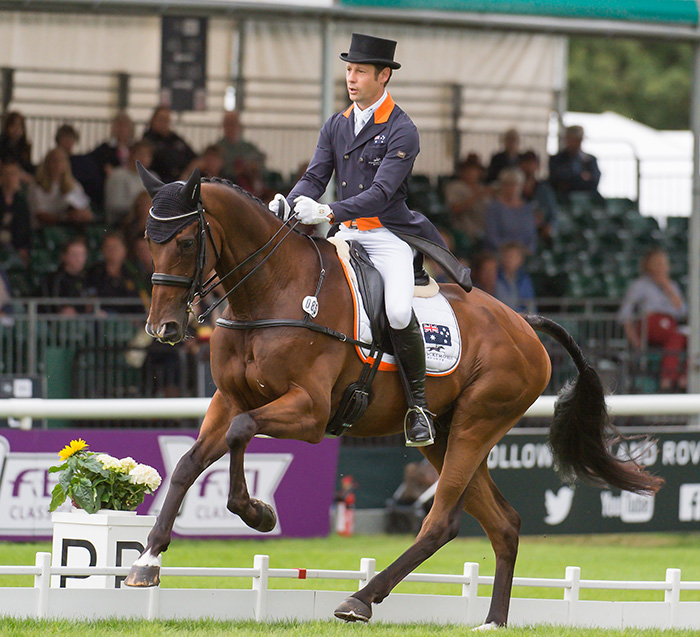
Chris and Nobilis at Burghley in 2016
And I know you know, that I agree with you…
“The issue of short or long format is an interesting debate. I spoke in depth with Blyth Tait at the WEG in Tryon, and he said he thinks there should still be an endurance element and I argued the opposite. I’m a huge fan of Blyth’s, and it was interesting to have the debate, and I’ve thought a lot about it since, and yes, I think there is a skill when you can preserve the horse around a four-star, ride steady, ride smoothly, ride accurately, and you get to the end with more petrol left in the tank. That’s what Blyth is talking about when he talks about the endurance element, but I don’t think we need to see tired horses in the sport, therefore, why not shorten the cross country to seven minutes?”
“We no longer see four-stars where you can ride really slowly all around the course and still finish inside the time. The course designers are not making it that simple, they are setting out to make the time tough to make, so that they don’t have to build un-jumpable fences and ugly lines. It is a difficult challenge for our sport. I don’t claim to be someone who can change the world, or change the sport, but I will simply say that I think we should go to short format.”
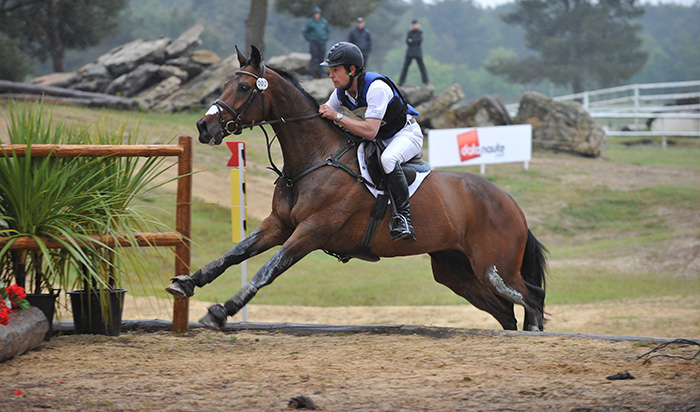
Winning Saumur in 2012 with Haruzac, only combination to take this approach…
Making the time has a lot to do with that ability to place the horse to very accurately determine lines…
“There’s quite a few things involved. One is seeing a distance, and the good showjumpers could turn their hand to the sport of eventing so easily. Another is tight lines and sometimes, going slower can be faster – little things, like turning up, not wasting ground. If there is a fence away from the line you’ve been heading on, turn up to the fence, like a showjumper would in a jump off. Sometimes the shortest line is faster than the outside line going for a gallop.”
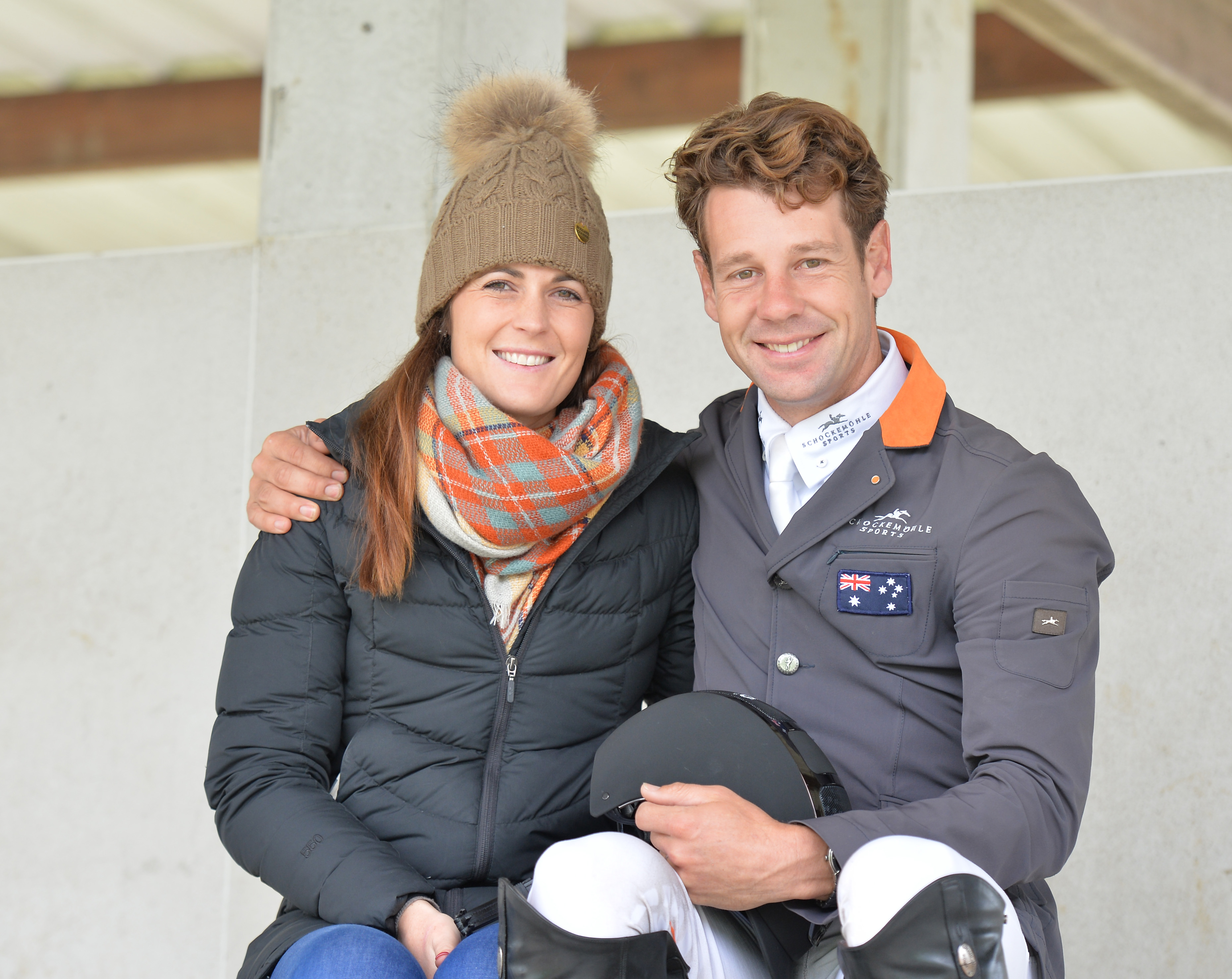
Chris and his wife, Bec
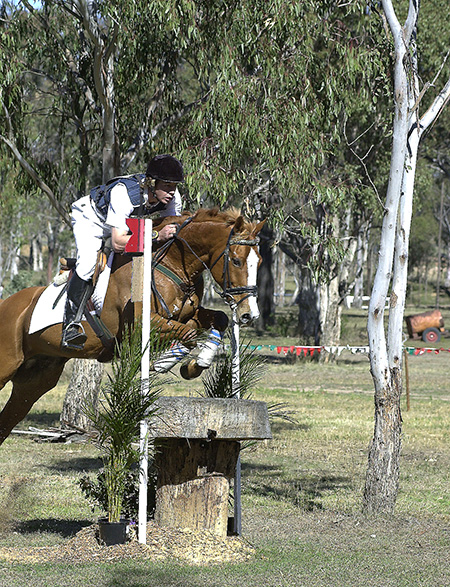
Where it all started, cross country amongst the gum trees at Warwick,
Chris with Deo Juvante…
Breeding eventers? How about Chacco Blue bloodlines? There’s a selection available from IHB: Like Diacontinus or Grey Top… Go to www.ihb.com.au
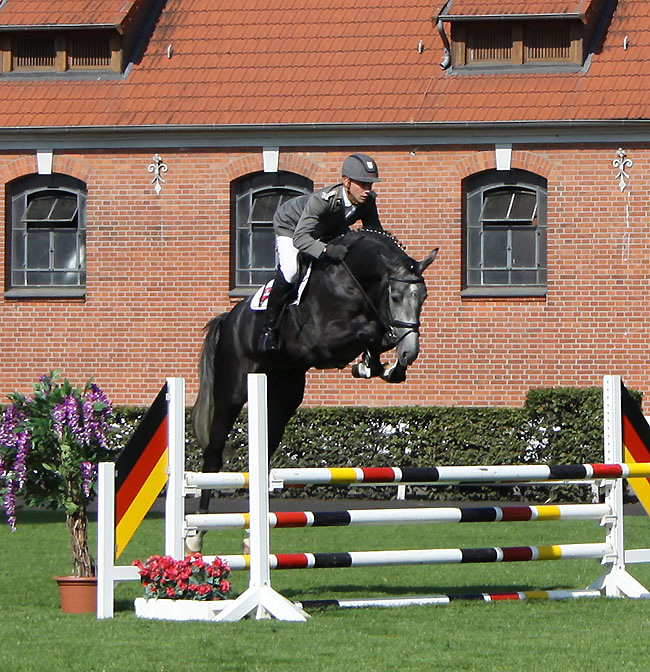
Or Grey Top

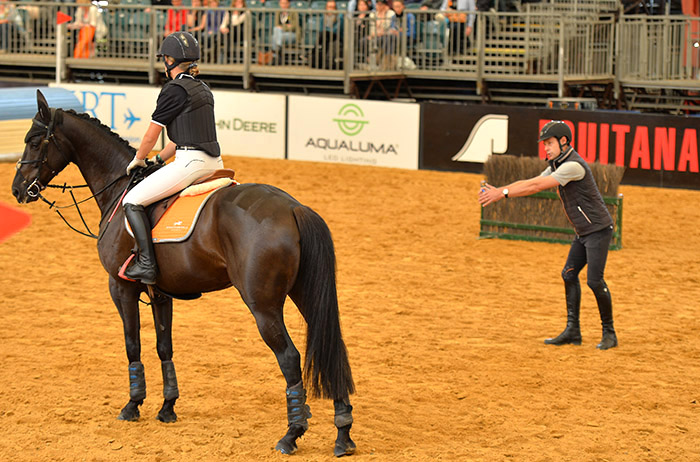
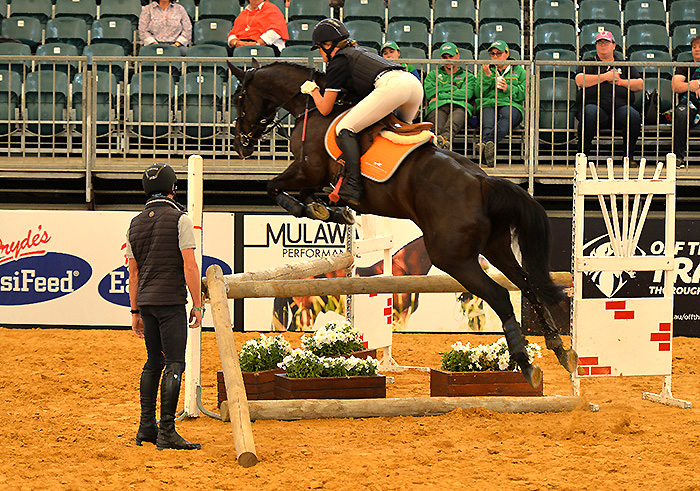
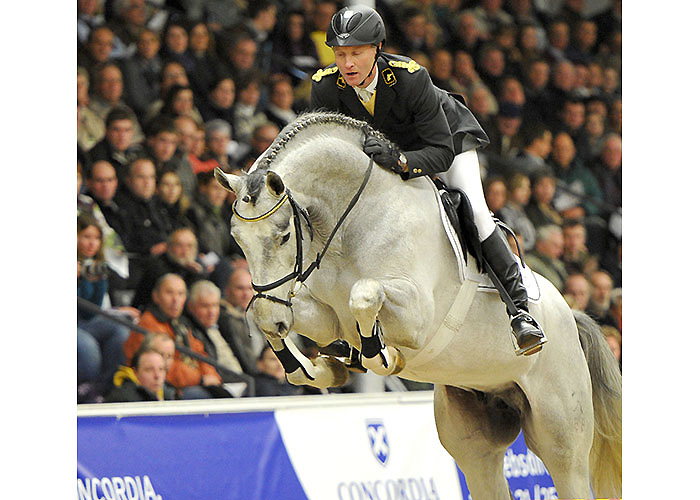
Thanks for your brilliant articles about Chris Burton and the french breeders 👍🏻